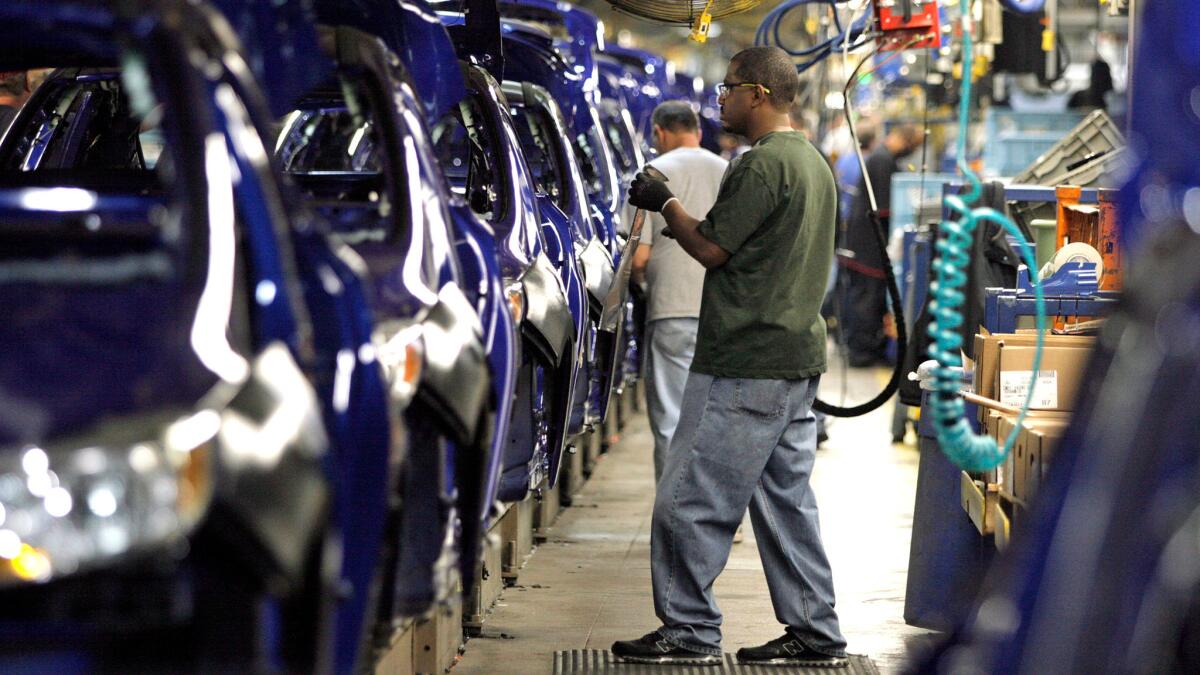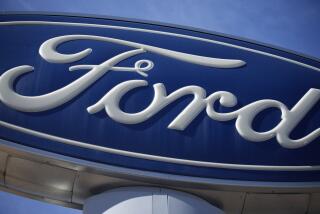Ford is moving all its North American small-car production to Mexico

Ford Motor Co. is shifting all of its North American small-car production to Mexico, Chief Executive Mark Fields said Wednesday.
“Over the next two to three years, we will have migrated all of our small-car production to Mexico and out of the United States,” Fields said.
Ford currently makes its Fiesta subcompact in Mexico, but its Focus and C-Max small cars are made in suburban Detroit. Making them in Mexico would boost company profits because of low wages there.
The company is building a $1.6-billion assembly plant in San Luis Potosi, Mexico. It plans to make small cars there starting in 2018.
Ford’s Michigan Assembly Plant, which currently makes the small cars, will be getting new products under a contract signed last year with the United Auto Workers union. They probably will be larger, more profitable vehicles such as the Ford Ranger pickup.
The industry has known for decades that domestic manufacturers struggle to make a profit on small cars. Shifting assembly to Mexico can reduce costs to a point.
Ford is looking at other ways to cut costs too. For example, Field said the current Ford Focus can be ordered in 300 configurations of options and colors. Ford wants to reduce that to 30, which would make production simpler and less expensive.

Mark Fields in 2015
Americans, however, prefer larger vehicles, especially pickups and higher-riding SUVs and crossover vehicles, for their personal use.
The future of smaller cars in the U.S. may depend on the ability to electrify their powertrains and introduce them to ride-sharing fleets in which they can generate revenue from fares paid by multiple riders.
Along those lines, Fields and other Ford executives outlined a $4.5-billion investment plan playing out over the next four years. It would include new models in segments such as commercial vehicles, trucks, SUVs and performance vehicles.
The automaker also reiterated its commitment to developing an autonomous vehicle by 2021. It believes that autonomous vehicles could account for up to 20% of vehicle sales by 2030.
The day’s announcements in Dearborn, Mich., were part of Ford’s corporate-strategy presentation to more than 100 analysts and investors. It comes as the U.S. auto industry’s six-year recovery is cooling and Britain’s exit from the European Union is presenting a new challenge to Ford’s rebound in Europe.
Ford shares have fallen nearly 14% so far this year. They sank 1.9% on Wednesday to $12.14.
Fields spent the first half of his 45-minute presentation assuring analysts that Ford’s core business remains strong, especially in its most profitable segments such as full-size pickup trucks, commercial vans and its resurgent Lincoln luxury brand.
But he also said the company must respond to a global shift away from personal vehicle ownership to one in which personal ownership will be challenged by on-demand shared mobility.
“This is very different thinking for us,” Fields said. “For most of our history, we have thought about the thing and how many of the things we have sold.”
In exploring how a traditional manufacturer can profit in a market in which the vehicle becomes a service platform, Fields said the first question he and fellow executives had to define is: “What’s our point of view on autonomy?”
“We see huge social, economic and environmental benefits. We’re focused on usage where miles traveled are as important as the number of units sold,” he said. “Autonomous vehicles will account for 1 of every 10 miles traveled by 2025, and will grow from 5% of all vehicles sold in U.S. in 2025 to 20% in 2030.”
Gardner writes for the Detroit Free Press. The Associated Press contributed to this report.
ALSO
Ford reveals a self-driving car — that has trouble with human politeness
Can the 2017 Chevy Bolt EV really go 200-plus miles with no recharge? We try it
My ride in a self-driving Uber; or how I learned to stop worrying and trust the algorithm
UPDATES:
2:10 p.m.: This article was updated with Ford shares’ closing price.
This article was originally published at 11:35 a.m.






